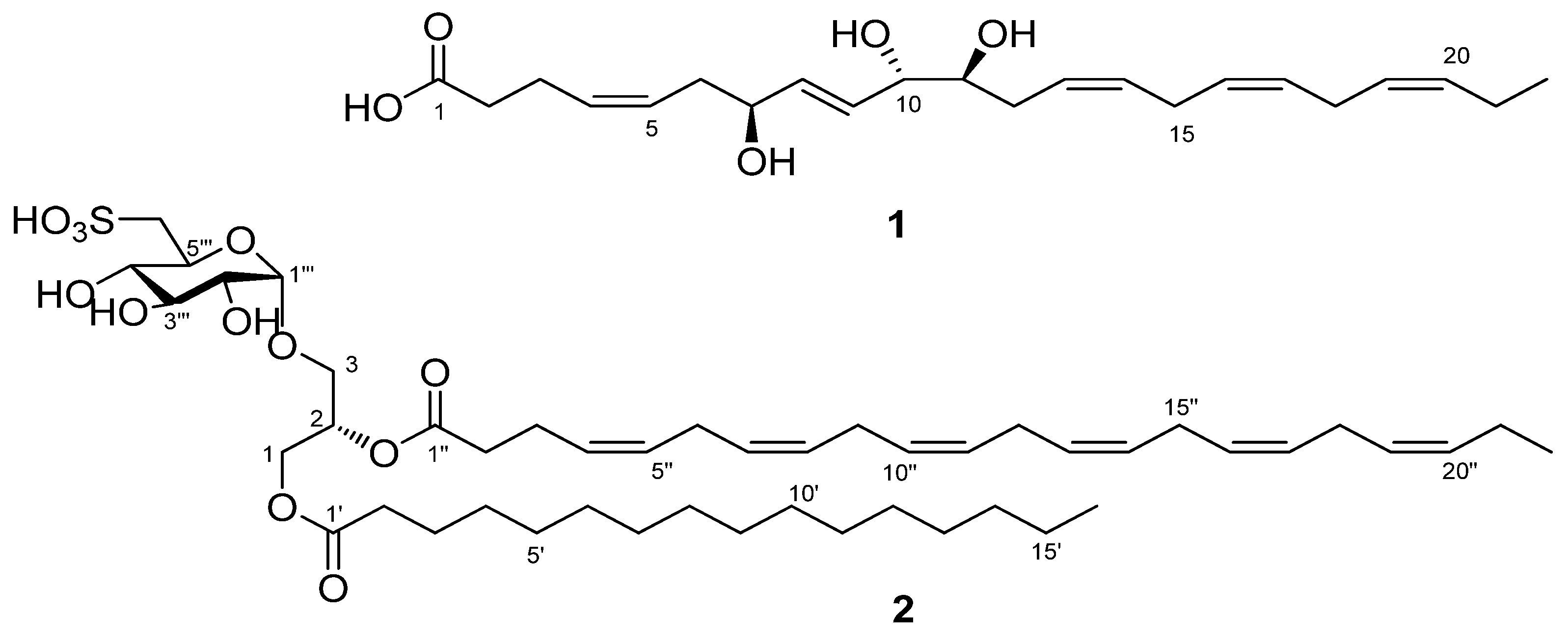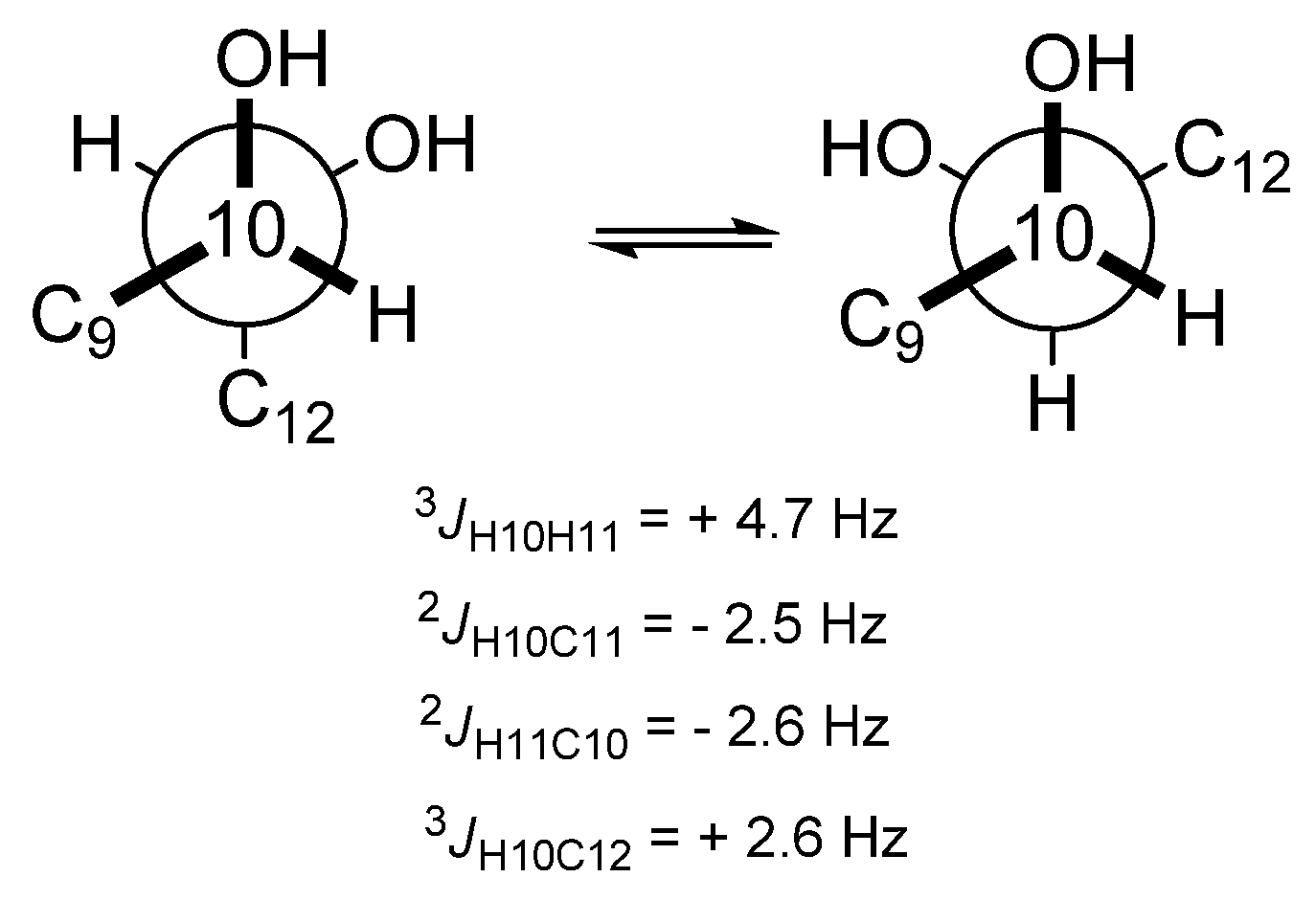Characterization of a New Trioxilin and a Sulfoquinovosyl Diacylglycerol with Anti-Inflammatory Properties from the Dinoflagellate Oxyrrhis marina
Abstract
:1. Introduction
2. Results and Discussion
3. Materials and Methods
3.1. General
3.2. Material
3.3. Extraction and Isolation
3.4. MTPA Reaction of Reduced Compound 1
3.5. Cell Cultures
3.6. Estimation of NO Production
3.7. Estimation of Cytotoxicity
4. Conclusions
Supplementary Materials
Acknowledgments
Author Contributions
Conflicts of Interest
References
- Dolan, J.R. Microphagous cilates in mesohaline Chesapeake Bay waters: Estimates of growth rates and consumption by copepods. Mar. Biol. 1991, 111, 303–309. [Google Scholar] [CrossRef]
- Jeong, H.J. The ecological roles of heterotrophic dinoflagellates in marine plankton community. J. Eukaryot. Microbiol. 1999, 46, 190–396. [Google Scholar] [CrossRef]
- Lowe, C.D.; Martin, L.E.; Montagnes, D.J.; Watts, P.C. A legacy of contrasting spatial genetic structure on either side of the Atlantic-Mediterranean transition zone in a marine protest. Proc. Natl. Acad. Sci. USA 2012, 109, 20998–21003. [Google Scholar] [CrossRef] [PubMed]
- Lund, E.D.; Chu, F.-L.E.; Harvey, E.; Adlof, R. Mechanism(s) of long chain n-3 essential fatty acid production in two species of heterotropic protists: Oxyrrhis marina and Gynodinium dominus. Mar. Biol. 2008, 155, 23–36. [Google Scholar] [CrossRef]
- Chu, F.-L.E.; Lund, E.D.; Podbesek, J.A. Quantitative significance of n-3 essential fatty acid contribution by heterotrophic protest and its ecological implication in marine pelagic food webs. Mar. Ecol. Prog. Ser. 2008, 354, 85–95. [Google Scholar] [CrossRef]
- Lowe, C.D.; Keeling, P.J.; Laura, E.; Martin, L.E.; Slamovits, C.; Phillip, C.; Watts, P.C.; Montagnes, D.J.S. Who is Oxyrrhis marina? Morphological and phylogenetic studies on an unusual dinoflagellate. J. Plankton Res. 2011, 33, 555–567. [Google Scholar] [CrossRef]
- Roberts, E.C.; Wootton, E.C.; Davidson, K.; Jeong, H.J.; Chris, D.; Lowe, C.D.; Montagnes, D.J.S. Feeding in the dinoflagellate Oxyrrhis marina: Linking behavior with mechanisms. J. Plankton Res. 2011, 33, 603–614. [Google Scholar] [CrossRef]
- Vogan, C.; Maskrey, B.H.; Taylor, G.W.; Henry, S.; Race-Asciak, C.R.; Clare, A.S.; Rowley, A.F. Hepoxilins and trioxilins in barnacles: An analysis of their potential roles in egg hatching and larval settlement. J. Exp. Biol. 2003, 206, 3216–3226. [Google Scholar] [CrossRef]
- Gauthier, K.M.; Chawengsub, Y.; Goldman, D.H.; Conrow, R.E.; Anjaiah, S.; Falck, J.R.; Campbell, W.B. 11(R),12(S),15(S)-trihydroxyeicosa-5(Z),8(Z),13(E)-trienoic acid: An endothelium-derived 15-lipoxygenase metabolite that relaxes rabbit aorta. Am. J. Physiol. Heart Circ. Physiol. 2008, 294, H1467–H1472. [Google Scholar] [CrossRef] [PubMed]
- Pfister, S.; Spitzbarth, N.; Nithipatikom, K.; Falck, J.R.; Campbell, W.B. Metabolism of 12-hydroperoxyeicosatetraenoic acid to vasodilatory trioxilin C3 by rabbit aorta. Biochim. Biophys. Acta 2003, 1622, 6–13. [Google Scholar] [CrossRef]
- Yu, Z.; Schneider, C.; Boeglin, W.E.; Brash, A.R. Epidermal lipoxygenase products of the hepoxilin pathway selectively activate the nuclear receptor PPARα. Lipids 2007, 42, 491–497. [Google Scholar] [CrossRef] [PubMed]
- Reynaud, D.; Pace-Asciak, C.R. Docosahexaenoic acid causes accumulation of free arachidonic acid in rat pineal gland and hippocampus to form hepoxilins from both substrates. Biochim. Biophys. Acta 1997, 1346, 305–316. [Google Scholar] [CrossRef]
- Ohta, K.; Mizushina, Y.; Hirata, N.; Takemura, M.; Sugawara, F.; Matsukage, A.; Yoshida, S.; Sakaguchi, K. Action of a new mammalian DNA polymerase inhibitor, sulfoguinovosyldiacylglycerol. Biol. Pharm. Bull. 1999, 22, 111–116. [Google Scholar] [CrossRef] [PubMed]
- Fan, G.; Kim, S.; Han, B.H.; Han, Y.N. Glyceroglycolipids, a novel class of platelet-activating factor antagonists from Kalimeris indica. Phytochem. Lett. 2008, 1, 207–210. [Google Scholar] [CrossRef]
- Banskota, A.H.; Stefanova, R.; Gallant, P.; Osborne, J.A.; Melanson, R.; O’Leary, S.J.B. Nitric oxide inhibitory activity of monogalactosylmonoacylglycerols from a freshwater microalgae Chlorella sorokiniana. Nat. Prod. Res. 2013, 27, 1028–1031. [Google Scholar] [CrossRef] [PubMed]
- Lauritano, C.; Anderson, J.H.; Hansen, E.; Albrigtsen, M.; Escalera, L.; Esposito, F.; Helland, K.; Hanssen, K.O.; Romano, G.; Ianora, A. Bioactivity screening of microalgae for antioxidant, anti-inflammatory, anticancer, anti-diabetes, and antibacterial activities. Front. Mar. Sci. 2016, 3, 68. [Google Scholar] [CrossRef]
- Gao, J.; Hu, L.; Dong, Z.; Liu, J. New Glycosphingolipid containing an unusual sphingoid base from the basidiomycete Polyporus ellisii. Lipids 2001, 36, 521–527. [Google Scholar] [CrossRef] [PubMed]
- Matsumori, N.; Kaneno, D.; Murata, M.; Nakamura, H.; Tachibana, K. Stereochemical determination of acyclic structures based on carbon-proton spin- coupling constants. A method of configuration analysis for natural products. J. Org. Chem. 1999, 64, 866–876. [Google Scholar] [CrossRef] [PubMed]
- Freire, F.; Seco, J.M.; Quiñoá, E.; Riguera, R. Determining the absolute stereochemistry of secondary/secondary diols by 1H NMR: Basis and applications. J. Org. Chem. 2005, 70, 3778–3790. [Google Scholar] [CrossRef] [PubMed]
- Keusgen, M.; Curtis, J.M.; Thibault, P.; Walter, J.A.; Windust, A.; Ayer, S.W. Sulfoquinovosyl Diacylglycerols from the alga Heterosigma carterae. Lipids 1997, 32, 1101–1112. [Google Scholar] [CrossRef] [PubMed]
- Ohta, K.; Mizushina, Y.; Hirata, N.; Hirata, N.; Takemura, M.; Sugawara, F.; Matsukage, A.; Yoshida, S.; Sakaguchi, K. Sulfoquinovosyldiacylglycerol, KM043, a new potent inhibiotor of eukaryotic DNA polymerases and HIV-reverse transcriptase type 1 from a marine red alga Gigartina tenella. Chem. Pharm. Bull. 1998, 46, 684–686. [Google Scholar] [CrossRef] [PubMed]
- Banskota, A.; Stefanova, R.; Sperker, S.; Lall, S.P.; Craigie, J.S.; Hafting, J.T.; Critchley, A.T. Polar lipids from the marine macroalga Palmaria palmata inhibit lipopolysaccharide-induced nitric oxide production in RAW264.7 macrophage cells. Phytochemistry 2014, 101, 101–108. [Google Scholar] [CrossRef] [PubMed]
- Napolitano, J.G.; Norte, M.; Padrón, J.M.; Fernándes, J.J.; Daranas, A.H. Belizeanolide, a cytotoxic macrolide from the dinoflagellate Prorocentrum belizeanum. Angew. Chem. Int. Ed. 2009, 48, 796–799. [Google Scholar] [CrossRef] [PubMed]
- Dawson, V.L.; Brahbhatt, H.P.; Mong, J.A.; Dawson, T.M. Expression of inducible nitric oxide synthase causes delayed neurotoxicity in primary mixed neuronal-glial cortical cultures. Neuropharmacology 1994, 33, 1425–1430. [Google Scholar] [CrossRef]



| Position | δC | δH (J in Hz) |
|---|---|---|
| 1 | 177.3, C | |
| 2 | 35.2, CH2 | 2.31, m |
| 3 | 24.2, CH2 | 2.33, m |
| 4 | 131.1, CH | 5.46, m |
| 5 | 127.6, CH | 5.47, m |
| 6 | 36.3, CH2 | 2.31, m |
| 7 | 73.0, CH | 4.10, dt (6.1, 6.1) |
| 8 | 136.2, CH | 5.72, dd (15.7, 6.1) |
| 9 | 130.9, CH | 5.78, dd (15.7, 6.1) |
| 10 | 76.0, CH | 3.96, dd (6.1, 4.7) |
| 11 | 75.9, CH | 3.53, dt (8.3, 4.7) |
| 12 | 31.8, CH2 | 2.18, dd (14.9, 8.3); 2.33, m |
| 13 | 127.4, CH | 5.49, m |
| 14 | 130.7, CH | 5.42, m |
| 15 | 26.8, CH2 | 2.84, dd (6.6, 6.1) |
| 16 | 129.0, CH | 5.34, m |
| 17 | 129.5, CH | 5.34, m |
| 18 | 26.4, CH2 | 2.81, dd (7.1, 5.9) |
| 19 | 128.2, CH | 5.29, m |
| 20 | 132.8, CH | 5.37, m |
| 21 | 21.5, CH2 | 2.08, q (7.3) |
| 22 | 14.7, CH3 | 0.96, t (7.6) |
| Position | δC | δH (J in Hz) |
|---|---|---|
| 1 | 64.2, CH2 | 4.18, dd (11.0, 6.9); 4.49, dd (11.0, 2.9) |
| 2 | 71.9, CH | 5.31, m |
| 3 | 67.1, CH2 | 3.57, dd (10.8, 6.4); 4.11, dd (10.8, 5.1) |
| 1′ | 175.1, C | |
| 2′ | 35.0, CH2 | 2.31, t (7.6) |
| 3′ | 26.0, CH2 | 1.54, q (7.6) |
| 4′ | 30.2, CH2 | 1.30, m |
| 5′–13′ | 30.8–30.5, CH2 | 1.30, m |
| 14′ | 33.1, CH2 | 1.26, m |
| 15′ | 23.7, CH2 | 1.30, m |
| 16′ | 14.4, CH3 | 0.89, t (6.9) |
| 1″ | 174.2, C | |
| 2″ | 35.1, CH2 | 2.39, m |
| 3″ | 23.7, CH2 | 2.39, m |
| 4″ | 130.1, CH | 5.37, m |
| 5″, 7″–8″, | 129.5–129.0, CH2 | 5.36, m |
| 10″–11″, 13″–14″ | ||
| 16″–17″, 19″ | ||
| 6″, 9″ 12″, 15″, 18″ | 26.6–26.5, CH2 | 2.85, m |
| 20″ | 132.8, CH | 5.36, m |
| 21″ | 21.5, CH2 | 2.08, q (7.6) |
| 22″ | 14.7, CH3 | 0.96, t (7.6) |
| 1‴ | 100.1, CH | 4.75, d (3.9) |
| 2‴ | 73.5, CH | 3.39, dd (9.8, 3.9) |
| 3‴ | 74.9, CH | 3.62, t (9.8) |
| 4‴ | 75.1, CH | 3.08, dd (9.8, 9.1) |
| 5‴ | 69.9, CH | 4.07, td (9.1, 2.0) |
| 6‴ | 54.3, CH2 | 2.91, dd (14.2, 9.1); 3.34, dd (14.2, 2.0) |
© 2017 by the authors. Licensee MDPI, Basel, Switzerland. This article is an open access article distributed under the terms and conditions of the Creative Commons Attribution (CC BY) license ( http://creativecommons.org/licenses/by/4.0/).
Share and Cite
Yoon, E.Y.; Yang, A.R.; Park, J.; Moon, S.J.; Jeong, E.J.; Rho, J.-R. Characterization of a New Trioxilin and a Sulfoquinovosyl Diacylglycerol with Anti-Inflammatory Properties from the Dinoflagellate Oxyrrhis marina. Mar. Drugs 2017, 15, 57. https://doi.org/10.3390/md15030057
Yoon EY, Yang AR, Park J, Moon SJ, Jeong EJ, Rho J-R. Characterization of a New Trioxilin and a Sulfoquinovosyl Diacylglycerol with Anti-Inflammatory Properties from the Dinoflagellate Oxyrrhis marina. Marine Drugs. 2017; 15(3):57. https://doi.org/10.3390/md15030057
Chicago/Turabian StyleYoon, Eun Young, A. Reum Yang, Jaeyeon Park, Seung Joo Moon, Eun Ju Jeong, and Jung-Rae Rho. 2017. "Characterization of a New Trioxilin and a Sulfoquinovosyl Diacylglycerol with Anti-Inflammatory Properties from the Dinoflagellate Oxyrrhis marina" Marine Drugs 15, no. 3: 57. https://doi.org/10.3390/md15030057






